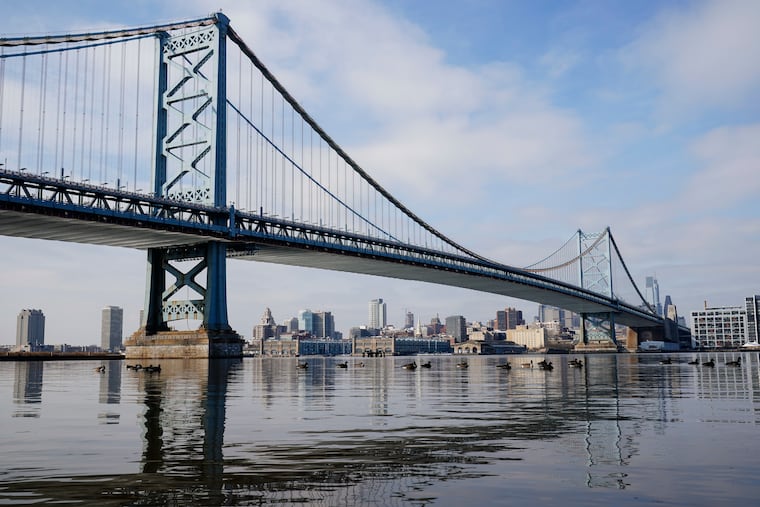Climate change should be a consideration in planning massive Fishtown housing developments | Opinion
Shortsighted decision-making in the wake of an oncoming climate calamity is everyone’s problem.

In a recent Fishtown Neighbors Association Zoning Committee meeting on Zoom, I was invited to voice my opinion about a 12-inch difference in the height of a neighbor’s replacement side yard fence. The other item on the agenda was a little different: the next phase of a massive, suburban-style subdivision — 120 townhouses, 50 duplexes, and 80 apartments — being built on the banks of the Delaware River.
The land surrounding this development is projected to be either underwater or functionally an island, even in the most optimistic climate change projections of the Intergovernmental Panel on Climate Change. Unlike the height of my neighbor’s fence, this project needed no vote, no input. The Northbank development has all the approvals it needs to be built, climate change be damned.
I know from my career as a journalist covering the environment that people everywhere should be retreating from shorelines. Anyone who has followed the news for the last 40 years — or who has ever built a sandcastle — intuitively knows that building up on shorelines is not a good idea. Especially now.
It’s easier to think about the costs of coastal development on, say, the Jersey Shore, where sea-level rise, sinking land, and intensifying storms will have waves pummeling beach houses and water backing up storm drains. But the Delaware River is also tidal. Parts of our city’s shoreline will flood, and that flooding is only going to get worse over the next 30 years.
Philadelphia’s zoning laws, combined with inaction at the federal level, mean that the Northbank development can continue “by right,” meaning that developers can build and home buyers can buy as is their legal right. Instead of developing land along the Delaware River, though, the most sensible thing would be to advance a sane policy of retreat.
When I see development along the riverfront in Fishtown, I think about the rights of my children, who are in elementary school. They will be among the taxpayers expected to foot the bill for keeping Northbank residents connected to the rest of the city for emergency services.
While Northbank itself might not flood, I am concerned about lower-lying land between it and the rest of my neighborhood — land which used to be the mouth of Aramingo Creek long before it was Aramingo Avenue. Based on elevation models compiled by the National Oceanic and Atmospheric Administration, this area will flood first. This means that ambulances and fire trucks and police SUVs may not be able to reach Northbank in the coming decades.
And when that happens — either from heavy rains or increasingly high tides — our children will bear the costs.
Shortsighted decision-making in the wake of an oncoming climate calamity is everyone’s problem. Where it might be easier to say “buyer beware” and abdicate responsibility to individuals who purchase homes along a waterfront in 2022 — when it comes to future taxes, emergency services, and so many other costs, all of us have a stake.
To be sure, the City of Philadelphia has done a lot to prepare for climate change. Philly was just recognized as one of the world’s top 95 cities for its “bold leadership on environmental action.” The Office of Sustainability has done excellent work in requiring buildings to use energy more efficiently, publishing a well-thought-out “Climate Action Playbook,” and pursuing environmental justice that doesn’t leave behind the communities of color that are all-too-often subjected to the worst effects of climate change and urban pollution. The city’s Office of Sustainability is focusing resources on Eastwick, a historically Black neighborhood that is regularly inundated where Cobbs and Darby Creeks converge. These are important efforts.
But along Philadelphia’s riverfronts, buildings are going up in areas that we know are going to flood. More than 600 new apartments are coming to the Navy Yard. New buildings will be constructed on the former PES refinery site in South Philly. And on the Delaware River in Fishtown, development is also being pushed through. I’m not a NIMBY, but a NIMBIIR: Not In My Backyard If It’s Riverfront.
Last summer, Philadelphia’s director of the Office of Sustainability, Christine Knapp, acknowledged the problem with unregulated, “piecemeal” development along our riverfronts in a Philadelphia Neighborhood Networks Zoom: “We need to have standards across the board that any new developments, that any new investments are made with the right science in mind,” Knapp said.
She continued: “When we let people build on the riverfront, it makes it worse for everyone else. But the city is also taking on the problem of what happens when that property floods and the city has to rescue folks, or the city has to be responsible for the response to that storm or that flood. It’s like a triple-edged problem. We absolutely need to get ahead of it.”
Philadelphians don’t have that protection yet. We need it. Until then, as Knapp said, property owners will develop riverfront land and push tomorrow’s floodwater into lower-lying, adjacent areas. This pushes the costs for responding to future storms and floods onto our city’s taxpayers.
Denis Devine is a Fishtown resident who has been concerned about climate change since covering erosion on the Atlantic and Pacific coasts as a journalist in Long Beach, N.Y., and San Diego in the 1990s and 2000s.